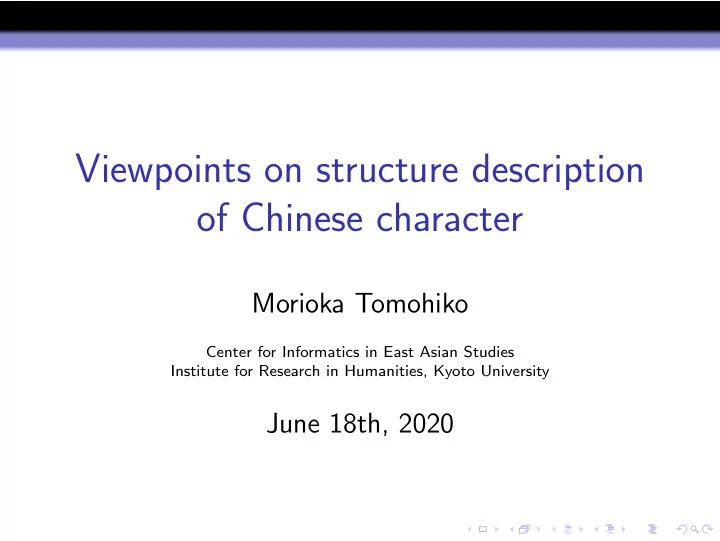

Viewpoints on structure description of Chinese character Morioka Tomohiko Center for Informatics in East Asian Studies Institute for Research in Humanities, Kyoto University June 18th, 2020
女 Introduction Many Chinese characters ( 漢字 ) are complex characters composed of multiple components. So we can describe their structures: e.g. 林 = ⿰ 木木 雲 = ⿱ 雨云 広 = ⿸ 广厶 But in some cases, their are ambiguity to analyze their structures and components: e.g. 旗 = ⿰ 方 or ⿸ 其 嬴 = ⿱ ⿲ 月女卂 or ⿵
Who am I? Works: CHISE (CHaracter Information Service Environment) http://www.chise.org/ Bibliography of Oriental Studies on the Web http://ruimoku.zinbun.kyoto-u.ac.jp/ MeCab-Kanbun (Morpheme Analyzer for classical Chinese; Joint research) https://corpus.kanji.zinbun.kyoto-u. ac.jp/gitlab/Kanbun/mecab-kanbun etc.
CHISE IDS database https://gitlab.chise.org/CHISE/ids one of the most comprehensive IDS dataset with a large number of characters that supports almost all CJKV Unified Ideographs coded in UCS. CHISE character ontology CHISE IDS database is a part of CHISE character ontology. Each components are defined in the ontology. CHISE IDS Find http://www.chise.org/ids-find a Web service for searching Chinese characters that contains specified components. It is also an entrance to the CHISE character ontology.
Structural description requirements There are a lot of Chinese characters, so it is not easy to maintain data quality. Versatility: Write once, use anywhere Consistency Coverage of components: describe all Chinese characters with as few components as possible Intelligibility (especially for native users and classical Chinese scholars) → We need models
Description based on apparent structure Components are a visible objects 林 = ⿰ 木木 雲 = ⿱ 雨云 Then, if 嬴 = ⿳ 亡口 ⿲ 月女卂 , is ⿲ 月女卂 a component?
Description based on functional structure Component is an interface to associate phonetic and/or semantic values and shapes → In this view, ⿲ 月女卂 is not a component If you do not know the target character, you will not know the functional components (maybe it is the goal)
「習」 「 」 「羽」 Description based on glyph design variation of component Component is a unit to describe glyph variations of Chinese characters. cf. unification rules 「 万 」 「習」 : 「羽」 If an abstract component 〈羽〉 = { 羽 , 万 , 羽 } is defined, it is possible to describe abstract character 〈習〉 = ⿱ 〈羽〉白
Description based on productivity Components are objects that combine them to create Chinese characters → Components that can produce many Chinese characters have high “componentness”. → If a component is included in only one Chinese character, it is meaningless to regard it as a component (inappropriate decomposition?) ・ Mechanical analysis is possible using the CHISE IDS database
」 「 」 「 」 ( 「 」 「 」 」 ) 「 「 」 「 」 「 」 「 「 」 「 」 「 「 」 ) 」 「 」 「 「 」 「 」 「羸」 「 」 「 」 「 」 In case 嬴 「 蠃 」 (贏 , 赢 , : 「嬴」 「 䇔 」 「 臝 」 「 驘 」 「 鸁 」 ( 䊨 ) 」 ... ⿲ 月女卂 : 「嬴」
( ( ( In case 族 : 斻 , 施 , 斾 , 斿 , 旂 , , 旃 , , 旄 , , 旅 , , 旇 , , 旊 , 旋 , 㫊 , 旌 , 旍 , 旎 , 族 , , 旆 , , 㫋 , , 旒 , 㫍 , , , , , 旐 , , , 旓 , , 旖 , , 㫎 , 㫏 , ( , , 旗 , ) , ← ? ) , 旚 , , , ← ? 旛) , , 旛 , , , , , , , , 旒 , , , , , 旟 , , , , , ) , , , ... : 族 , ,
Occurrence of components 100000 CHISE-IDS: prioritizes functional structures, but apparent structures remains CJKV-IDS (by Kawabata): prioritizes apparent structures 10000 log(number of characters including component) 1000 100 10 1 1 10 100 1000 10000 log(rank) This distribution seems to follow the Zipf’s law
( ) Equivalence In many cases, descriptions based on apparent structure and descriptions based on functional structure have equivalent information. We can write rewriting rules: e.g. ⿸⿰ ABC → ⿰ A ⿱ BC (旗: ⿸ 其 → ⿰ 方 ⿹⿰ ABC → ⿰⿱ ABC : ⿹ 須女 → ⿰⿱ 彡女頁) Term Rewriting Systems (TRS) can also normalize glyph variants with unification rules.
Ambiguity of apparent structure 虛 : ⿸ 虍 → ⿸ 華 ⿱ 七 → ⿱⺊⿸ ⿱ 七 Apparent component is also depended on knowledge.
Conclusion Structural description of Chinese character should be based on Chinese character analysis (Chinese character studies), like grammatical analysis of natural language. It depends on knowledge, but statistical analysis for CHISE-IDS database helps discover this knowledge. productivity of components Grapholinguistic model and algebraic model (such as Term Rewriting System) are the two wheels to describe structure of Chinese characters.
Recommend
More recommend